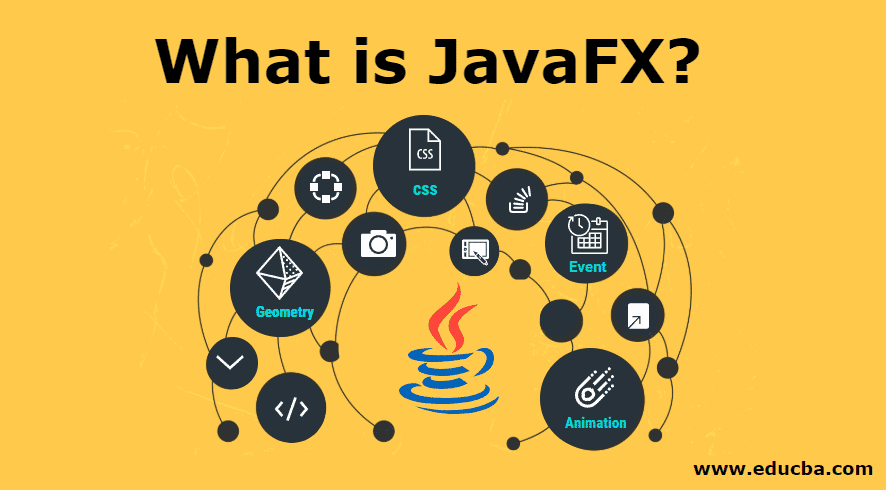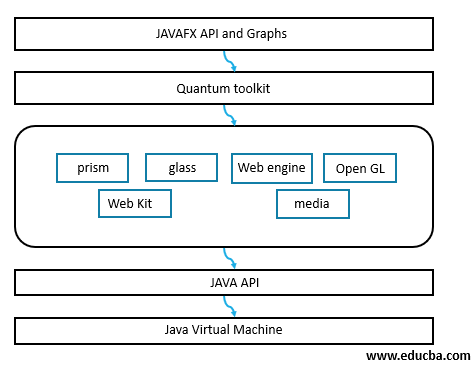Updated March 17, 2023
Introduction to JavaFX
The software platform to create and deliver desktop applications in any type of devices is called JavaFX. It can also be used in internet applications. It is written in JavaFX Script. It is a different language when compared with Java, and the syntax is also different. JavaFX stands for special effects in the Java language. Internet applications are made richer with different plugins with the help of JavaFX. This is an alternative to the ways for building a website or any other applications. We can say JavaFX is a declarative and statically typed scripting language.
The way to import features provided by JavaFX we can import them like the example provided below:
Code:
import javafx.application.Application;
import javafx.scene.layout.VBox;Code in JavaFX works similarly to code in Java works. The JavaFX coding structure revolves around the OOPs concept (class, object, inheritance…). JavaFX library is available as a public java API. You are just a click away from experiencing the agility provided by JavaFX.
Why do we need JavaFX?
- Every vendor to convert his website into more user-friendly, interactive websites with rich graphics used in this competitive era. JavaFX came into the market for the development of rich internet applications primarily. These applications give similar features as offered by desktop applications but with a better visual experience. These applications are provided as a plugin or extension to the browser or sometimes with the help of virtual machines.
- These applications add to the user experience as it modifies the normal web application into more engaging, well animated and interactive. These applications do not require separate software to run on; this feature makes such applications lightweight and easily usable. You may have to add software like ActiveX, Flash, etc., to experience these applications’ visual effects. It can be called as server-dependent as all the data manipulations to it are done via server.
- It provides various functionalities that are built by extending existing libraries like swing and advance windowing toolkit to develop such applications all contained in a single component. It will provide flexibility to coders to develop rich applications; for example, CaptainCasa has moved to JavaFX from the swing.
- With an increasing number of browsers having their protocols and also javascript is becoming more complex looking at current business requirements, there is a need to have a more generic technology containing wide features. JavaFX fits to cater to this.
How JavaFX works?
- JavaFX will include the library : javafx.application.Application in the starting. This way, we will derive the basic functions of javaFX.
- It provides multiple functions and libraries to control the GUI the way the user wants. We can add event handler functionalities, and on the particular event, we can trigger the animation.
- All these features are provided in the library; we need to include the library and utilize the functionality already invented. There are various packages in these libraries to support the huge number of interactive features provided as a part of the kit.
Some of the important packages provided as part of the JavaFX library are listed below:
- geometry: this feature provides 2D objects to be used in applications.
- css: This contains classes to have CSS like styling.
- event: This contains classes to handle events
- animation: This contains animation linked classes and objects such as fill, shade with the transition time.
Features of JavaFX
Some of the main features of are listed below:
- It is written in JAVA. This rich technology comes under Java toolkit version 8 or above.
- This technology supports CSS styling.
- It provides a javascript engine.
- We can have a 2D/3D graphics object added to our applications.
- It supports image, media format (mp3, aiff) and video (flv).
- It has a webview so that HTML components as well can be added with JavaFX.
- Since it is built on top of swing so we can use swing features as well in JavaFX.
- It supports the use of XML to have separate data structures differently maintained from application code.
- You can avoid hassles of browser dependent errors of HTML, performance issues with the richness of JavaFX technology.
JavaFX Architecture
Java FX architecture can be well understood from the below diagram. JavaFX APIs work on top of various layers. Beneath these APIs, there are many supporting functionalities on which Java FX is built. Here it is working on top of the quantum toolkit. This toolkit works on different tools that support this toolkit. These tools are openGL, Web engine, glass, prism. Web toolkit and others. These all tools have a single base on which everything is built; this single most important thing is JAVA language. JAVA language is processed using a java virtual machine facilitated by byte codes.
How will this Technology help you in Career Growth?
- “Coder is never jobless”, especially if he/she knows JAVA. So it’s never a bad idea if you are already into Java to add JavaFX to your skillset. It is one of the latest functionalities released with java tool kit 8 and above. It has been decided to remove it from java toolkit 11 and provide a separate module of java for developing rich internet applications development.
- So, there is big new technology out our way, then why not we understand how it works now to create such applications.
- It is open-source since 2011 and constantly taken care of by the openFX community. Good coders can use its open-source feature to their advantage by tweaking it into its code and make something interesting of their own and publish in the openFX community so that it can be used anywhere by anyone. So the career prospects for those who wish to learn JavaFX are bright.
Conclusion
It will be supported by oracle till 2022 and, after that, will be taken care of by the OpenFX community. There is a plan by the oracle to release a new module to handle rich applications over the internet as demand to have such applications has risen manifold over the past years. It still makes sense to use JavaFX where the data and a large amount of interaction are involved, reducing the hassles of HTML and javascript code.
Recommended Articles
This is a guide to What is JavaFX. Here we discuss How it works with Features, Architecture and Career Growth. You may also look at the following article to learn more –



